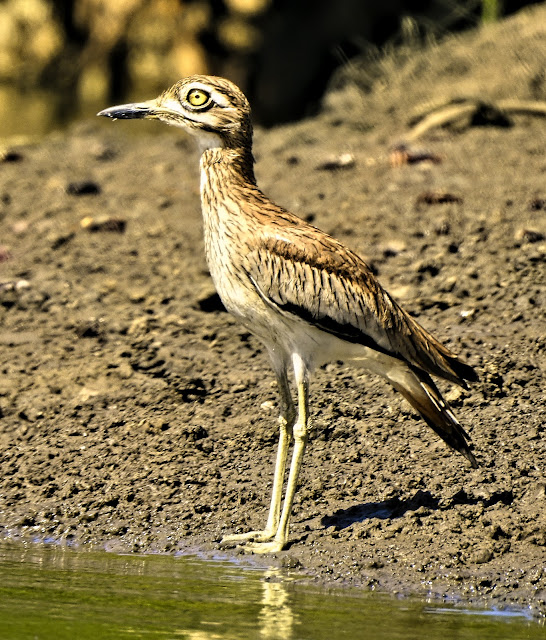This Blog contains Wildlife and Bird Photos from Walks, Safaris, Birding Trips and Vacations. Most of the pictures have been taken with my Nikon P900 and P950X cameras. On the right of the page are labels for each species of Bird/Animal etc. Click on a label and it will show all of the photos taken for that species. I am adding as much information for each species as I can from sources Wikipedia. To see any pictures at full size just click on the picture.
TOTAL PAGEVIEWS
TRANSLATE
Wednesday 4 January 2023
Tuesday 3 January 2023
Monday 2 January 2023
30-12-2022 NGALA LODGE, GAMBIA - AFRICAN THRUSH (Turdus pelios)
The African thrush or West African thrush (Turdus pelios) is a passerine bird in the thrush family Turdidae. It is common in well-wooded areas over much of the western part of sub-Saharan Africa, it was once considered to be conspecific with the olive thrush but that species has now been split further. Populations are resident (non-migratory).
The African thrush is normally encountered either singly or in pairs and is shy and retiring, preferring to remain in cover, but will come out and gather at fruiting trees. Usually forages in the ground, flicking leaf litter and searching through vegetation. Where undisturbed or habituated to people will feed out in the open in a similar fashion to the song thrush in Europe, and it is also reported to crack open snails on an anvil stone like a song thrush. Foraging is crepuscular and fruit, especially that of the nim Azadarichta indica, as well as figs, papaya, berries and seeds, makes up most of the diet supplemented with invertebrates and the occasional small fish.
Breeding is recorded in all months, but breeding activity peaks in the wet season, which is March to September or October in West Africa, April–July in Ethiopia and November to March in the rest of its range. The nest is cup shaped and bulky and is constructed using plant fibres and mud lined with fine grasses, leaves and roots. This nest is placed on a horizontal branch, in a tree fork or among vines, usually at a height lower than 10 m from the ground. It may re-use the abandoned nest of another species. The female is responsible for incubating the normal clutch of 2–3 eggs; both sexes feed the young. It is double brooded.
17-12-2022 PELICAN ISLAND, THE GAMBIA - AFRICAN SPOONBILL (Platalea alba)
The African spoonbill (Platalea alba) is a long-legged wading bird of the ibis and spoonbill family Threskiornithidae. The species is widespread across Africa and Madagascar, including Botswana, Kenya, Mozambique, Namibia, South Africa, and Zimbabwe.
It lives in marshy wetlands with some open shallow water and nests in colonies in trees or reedbeds. They usually don't share colonies with storks or herons. The African spoonbill feeds in shallow water, and fishes for various fish, molluscs, amphibians, crustaceans, insects and larvae. The animal uses its open bill to catch foods by swinging it from side-to-side in the water, which catches foods in its mouth. Long legs and thin, pointed toes enable it to walk easily through varying depths of water.
The African spoonbill is almost unmistakable through most of its range. The breeding bird is all white except for its red legs and face and long grey spatulate bill. It has no crest, unlike the common spoonbill. Immature birds lack the red face and have a yellow bill. Unlike herons, spoonbills fly with their necks outstretched.
Sunday 1 January 2023
17-12-2022 KARTONG, THE GAMBIA - AFRICAN PIED KINGFISHER (Ceryle rudis ssp rudis)
The pied kingfisher (Ceryle rudis) is a species of water kingfisher widely distributed across Africa and Asia. Originally described by Carl Linnaeus in 1758, it has five recognised subspecies. Its black and white plumage and crest, as well as its habit of hovering over clear lakes and rivers before diving for fish, make it distinctive. Males have a double band across the breast, while females have a single gorget that is often broken in the middle. They are usually found in pairs or small family groups. When perched, they often bob their head and flick up their tail.
Subscribe to:
Posts (Atom)































%201.jpg)
%202.jpg)
%203.jpg)



%201.jpg)
%202.jpg)
%201.jpg)
%202.jpg)
%203.jpg)
%201.jpg)
%202.jpg)

%201.jpg)





